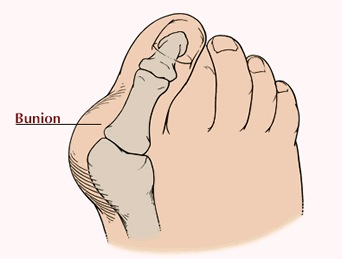Bunions are caused by a poor alignment of the foot and joint of the big toe. A bump develops on the inner side of the foot near the base of the first toe this is the bunion. The toe twists so that the inside edge touches the ground and the outside edge turns upward. In other words, it describes the deviation of the toe toward the outside of the foot.
The inherited shape of the foot may predispose people to bunions. For example, flat feet are unstable and in walking the body weight is repeatedly transferred to the big toe. This transfer of weight allows certain muscles to become stronger than others. This overpowering of muscles causes the toe to bend and deform. Women who wear tight, pointy-toed, or high-heeled shoes and shoes that are too small are susceptible to getting bunions. Improper boots and shoes exacerbate the underlying cause of flat, unstable feet.
Where a mild bump or outward bending of the big toe seems only a cosmetic concern at first, there are, unfortunately, other more negative forces going on with the foot. Because the foot is misaligned, the forces at work can draw the big toe farther out of line and then eventually causing it to be enlarged and deformed. As the foot itself and then the shape of the foot become altered so does the biometrics of walking. Normally, the big toe can bend at least 65 degrees, enabling it to be the last part of the foot to leave the ground during walking. However, the big toe cannot function properly and the body weight is transferred to the bunion.
Uncomfortable bunions gradually cause a person to compensate by walking in an exaggerated toe-turned-out manner, so the painful toe does not have to bend as far. Walking with the feet turned out forces the big toe even farther out, causing the bunion to worsen. Without treatment from a foot specialist or Podiatrist, the deformity eventually becomes disabling.




